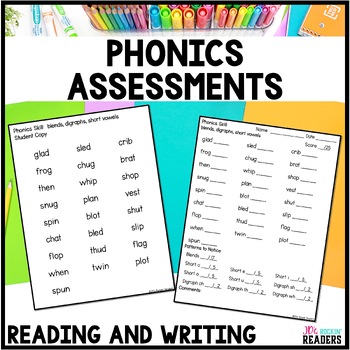Phonics Assessment - Decoding - Formative Assessment - Science of Reading
- Zip
What educators are saying
Description
Phonics assessments can be used to better understand what phonics skills your students need to practice. Each no-prep phonics assessment is easy to administer and analyze. There are 5 reading assessments and 5 writing assessments. Included are CVC words, short vowels, blends, digraphs, long vowels, silent e, and inflectional endings. These phonics assessments are great for documentation for RTI intervention or for classroom assessments. You can assess before and after the intervention to report student progress.
Reading Assessments- These are given individually to each student.
- CVC Words
- Blends, Digraphs, and Short Vowels
- Blends, Long/Short Vowels
- Short/Long Vowels, Silent E
- Inflectional Endings (s, ed, ing)
Writing Assessments- These can be given in small groups or a whole group like a spelling test.
- CVC Words
- Blends, Digraphs, and Short Vowels
- Blends, Long/Short Vowels
- Short/Long Vowels, Silent E
- Inflectional Endings (s, ed, ing)
Check out what other teachers are saying about this product:
- Sonia H. says, "This is the perfect resource to collect data on what skills each child has mastered and which they still need to work on. Makes it perfect to build small groups and to keep students moving without having to guess or give time-consuming assessments."
- Annalissa R. says, "This was an excellent tool for assessing early phonemic awareness. The difference between reading and written text were particularly helpful in working out some processing issues in my students."
You may also like:
- Bundled Phonics Literacy Center Activities
- Phonics Activities and Lessons (Rockin' Phonics Bundled)
- Phonics Differentiated Read the Room BUNDLE
- Phonics Puzzles
_______________________________________________________
Don't forget- leaving feedback earns you TPT credits toward free TPT purchases!
FOLLOW ME to be notified when new resources are uploaded AND I offer 20% off my products for the first 48 hours. It pays to follow.
_______________________________________________________
Copyright © JD'sRockinReaders.
All rights reserved by the author.
Permission to copy for single classroom use only.
Not for public display.
Please purchase additional licenses if you intend to share this product.
_______________________________________________________





